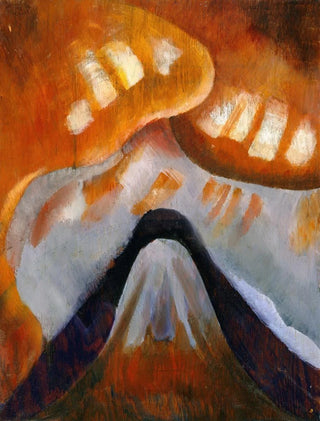Art print | Mountain and sky - Arthur Dove


View from behind

Frame (optional)
In the vast panorama of art history, certain works stand out for their ability to transcend the mere pictorial frame and invite the viewer to a deeper contemplation. "Montagne et ciel" by Arthur Dove is a perfect example. This canvas, both vibrant and soothing, transports us into a universe where nature and abstraction intertwine harmoniously. Through fluid shapes and delicate colors, Dove manages to capture the very essence of the relationship between man and his environment. The magic of this piece lies in its capacity to evoke emotions while leaving room for personal interpretation, a fundamental aspect of modern art.
Style and uniqueness of the work
The artwork "Montagne et ciel" is characterized by a unique style that combines abstraction and representation. Dove, a pioneer of American modern art, uses organic shapes and color palettes inspired by the landscapes he cherished so much. Shades of blue and green, mixed with touches of terracotta, create a serene atmosphere that invites escape. This art print does not merely depict a mountain or a sky; it evokes a sensory experience, a moment suspended in time. The composition, both balanced and dynamic, allows the eye to travel across the piece, discovering subtle details with each glance. Dove thus succeeds in transforming a landscape into a visual melody, where each color and shape sing the harmony of nature.
The artist and his influence
Arthur Dove, born in 1880, is often regarded as one of the pioneers of abstract art in the United States. His artistic vision, nourished by personal experiences and his love of nature, paved the way for many artists who followed in his footsteps. His innovative approach, which favors sensation over faithful representation, influenced generations of creators, from abstract expressionists to contemporary artists. Dove was able to incorporate elements of American culture into his work, while drawing inspiration from European movements such as Fauvism and Cubism. His legacy is palpable in the way modern art continues to explore the relationships between color, form, and the environment.

Matte finish

View from behind

Frame (optional)
In the vast panorama of art history, certain works stand out for their ability to transcend the mere pictorial frame and invite the viewer to a deeper contemplation. "Montagne et ciel" by Arthur Dove is a perfect example. This canvas, both vibrant and soothing, transports us into a universe where nature and abstraction intertwine harmoniously. Through fluid shapes and delicate colors, Dove manages to capture the very essence of the relationship between man and his environment. The magic of this piece lies in its capacity to evoke emotions while leaving room for personal interpretation, a fundamental aspect of modern art.
Style and uniqueness of the work
The artwork "Montagne et ciel" is characterized by a unique style that combines abstraction and representation. Dove, a pioneer of American modern art, uses organic shapes and color palettes inspired by the landscapes he cherished so much. Shades of blue and green, mixed with touches of terracotta, create a serene atmosphere that invites escape. This art print does not merely depict a mountain or a sky; it evokes a sensory experience, a moment suspended in time. The composition, both balanced and dynamic, allows the eye to travel across the piece, discovering subtle details with each glance. Dove thus succeeds in transforming a landscape into a visual melody, where each color and shape sing the harmony of nature.
The artist and his influence
Arthur Dove, born in 1880, is often regarded as one of the pioneers of abstract art in the United States. His artistic vision, nourished by personal experiences and his love of nature, paved the way for many artists who followed in his footsteps. His innovative approach, which favors sensation over faithful representation, influenced generations of creators, from abstract expressionists to contemporary artists. Dove was able to incorporate elements of American culture into his work, while drawing inspiration from European movements such as Fauvism and Cubism. His legacy is palpable in the way modern art continues to explore the relationships between color, form, and the environment.






